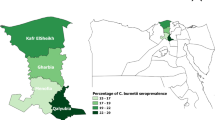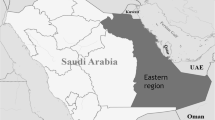Abstract
Objective
Q fever is a main occupational zoonotic disease. Slaughterhouse is one of the most remarkable ways of transmitting the infection from livestock to humans. This study aimed to survey the prevalence of Q fever in slaughterhouse workers in Fars province, Iran, for the first time.
Methods
Ninety serum samples were collected from slaughterhouse workers and tested to detect Immunoglobulin G (IgG) against Coxiella burnetii using ELISA and indirect immunofluorescence assay (IFA). PCR was also applied to identify C. burnetii DNA in the blood samples.
Results
Q fever seroprevalence was found at 26.7% in ELISA, showing recent infection. This result indicates that Q fever seroprevalence is relatively high in the Fars region. IFA showed a high seroprevalence of total IgG antibodies at 1:64 titer (73.3%) and relatively high IgG at 1:256 titer (40%) against C. burnetii. 2.2% of the workers were recognized as having probable acute Q fever. The IgG II prevalence at 1:64 and 1:256 titers was, respectively, 63.3% and 24.4% positive. The IgG I prevalence at 1:64 and 1:256 titers was also found 33.3% and 22.2% positive, respectively. Molecular prevalence of Q fever was also 8.9%. A significant relationship was found between IgG I seropositivity and longer work experience and employing other livestock-related jobs (animal husbandry and butchery) (P < 0.05).
Conclusions
As such, the high seroprevalence of Q fever among abattoir workers highlights the importance of further comprehensive epidemiological studies, occupational screening programs, and preventive measures for Q fever in high-risk groups. This also warns animal health care organizations about the risk of Q fever infection in livestock in this region.


Similar content being viewed by others
Data availability
Data are available on request from the authors.
References
Adebowale O, Fasanmi OG, Awosile B, Afolabi M, Fasina FO (2021) Systematic review and meta-analysis of veterinary-related occupational exposures to hazards. Open Vet Sci 2(1):6–22. https://doi.org/10.1515/ovs-2020-0104
Anderson A, Bijlmer H, Fournier P-E, Graves S, Hartzell J, Kersh GJ, Limonard G et al (2013) Diagnosis and management of Q fever—United States, 2013: recommendations from CDC and the Q Fever Working Group. MMWR Morb Mortal Wkly Rep. 62(3):1–29. https://www.jstor.org/stable/24832551
Carde O, Sanfeliu I, Font B, Mu Oz T, Nogueras M,Segura F (2006) Short report: seroprevalence of human infection by Coxiella burnetii in Barcelona (northern Spain). Am J Trop Med Hyg. 75:33–35. https://www.pubmed.ncbi.nlm.nih.gov/16837705/
Carrieri M, Tissot-Dupont H, Rey D, Brousse P, Renard H, Obadia Y, Raoult D (2002) Investigation of a slaughterhouse-related outbreak of Q fever in the French Alps. Eur J Clin Microbiol Infect Dis 21(1):17–21. https://doi.org/10.1007/s10096-001-0645-5
Casolin A (1999) Q fever in New South Wales department of agriculture workers. J Occup Environ Med. 273–278. https://www.jstor.org/stable/44994955
CDC (2019) Q fever, signs and symptoms. Retrieved 15-01-19, from https://www.cdc.gov/qfever/symptoms/index.html
CDC (2021) Q fever, epidemiology and statistics. Retrieved 06-08-21, from https://www.cdc.gov/qfever/stats/index.html
Cetinkaya B, Kalender H, Ertas H, Muz A, Arslan N, Ongor H, Gurcay M (2000) Seroprevalence of coxiellosis in cattle, sheep and people in the east of Turkey. Vet Rec 146(5):131–136. https://doi.org/10.1136/vr.146.5.131
Chu H, Yoo S-J, Hwang K-J, Lim H-S, Lee K, Park M-Y (2017) Seroreactivity to Q fever among slaughterhouse workers in South Korea. J Prev Med Public Health 50(3):195. https://doi.org/10.3961/jpmph.17.017
Dabaja MF, Greco G, Villari S, Bayan A, Vesco G, Gargano V, Arnone M et al (2018) The first serological study of Q fever in humans in Lebanon. Vector Borne Zoonotic Dis 18(3):138–143. https://doi.org/10.1089/vbz.2016.2102
Derrick E (1937) “Q” Fever, a new fever entity: clinical features, diagnosis and laboratory investigation. Med J Aust. 2(8):281–299. https://www.cabdirect.org/cabdirect/abstract/19382900070
ECDC (2019). Q fever, annual epidemiological report for 2019. Retrieved from https://www.ecdc.europa.eu/sites/default/files/documents/AER-Q-fever-2019.pdf
Esmaeili S, Pourhossein B, Gouya MM, Amiri FB, Mostafavi E (2014) Seroepidemiological survey of Q fever and brucellosis in Kurdistan province, western Iran. Vector Borne Zoonotic Dis 14(1):41–45. https://doi.org/10.1089/vbz.2013.1379
Esmaeili S, Naddaf SR, Pourhossein B, Hashemi Shahraki A, Bagheri Amiri F, Gouya MM, Mostafavi E (2016) Seroprevalence of brucellosis, leptospirosis, and Q fever among butchers and slaughterhouse workers in south-eastern Iran. PLoS ONE 11(1):e0144953. https://doi.org/10.1371/journal.pone.0144953
Esmaeili S, Amiri FB, Mokhayeri H, Kayedi MH, Maurin M, Rohani M, Mostafavi E (2019) Seroepidemiological study of Q fever, brucellosis and tularemia in butchers and slaughterhouses workers in Lorestan, western of Iran. Comp Immunol Microbiol Infect Dis 66:101322. https://doi.org/10.1016/j.cimid.2019.06.003
España PP, Uranga A, Cillóniz C, Torres A (2020) Q Fever (Coxiella Burnetii). Paper Present Semin Respir Crit Care Med. https://doi.org/10.1055/s-0040-1710594
Greiner AL, Bhengsri S, Million M, Edouard S, Thamthitiwat S, Clarke K, Kersh GJ et al (2018) Acute Q fever case detection among acute febrile illness patients, Thailand, 2002–2005. Am J Trop Med Hyg 98(1):252. https://doi.org/10.4269/ajtmh.17-0413
ILO (2020) Summary of work-related mortality. World Bank division. Available 28-04–20, at: https://www.ilo.org/moscow/areas-of-work/occupational-safety-and-health/WCMS_249278/lang--en/index.htm
Jalal RB, Saeed AY (2019) Seroprevalence of Coxiella burnetii among meat Handlers in Duhok City Iraq. JDU 22(1):52–57. https://doi.org/10.26682/sjuod.2019.22.1.8
Kato K, Arashima Y, Asai S, Furuya Y, Yoshida Y, Murakami M, Takahashi Y et al (1998) Detection of Coxiella burnetii specific DNA in blood samples from Japanese patients with chronic nonspecific symptoms by nested polymerase chain reaction. FEMS Immunol Med Microbiol 21(2):139–144. https://doi.org/10.1111/j.1574-695X.1998.tb01159.x
Khalili M, Mosavi M, Diali HG, Mirza HN (2014) Serologic survey for Coxiella burnetii phase II antibodies among slaughterhouse workers in Kerman, southeast of Iran. Asian Pac J Trop Biomed 4:S209–S212. https://doi.org/10.12980/APJTB.4.2014C1268
Marrie TJ, Minnick MF, Textoris J, Capo C, Mege J-L (2015) Coxiella. Molecular medical microbiology, 2nd edn. Elsevier, Amsterdam, pp 1941–1972. https://doi.org/10.1016/B978-0-12-397169-2.00106-2
Mathews KO, Toribio J-A, Norris JM, Phalen D, Wood N, Graves SR, Sheehy PA et al (2021) Coxiella burnetii seroprevalence and Q fever in Australian wildlife rehabilitators. One Health 12:100197. https://doi.org/10.1016/j.onehlt.2020.100197
Mohabbati Mobarez A, Bagheri Amiri F, Esmaeili S (2017) Seroprevalence of Q fever among human and animal in Iran; a systematic review and meta-analysis. PLOS Negl Trop Dis 11(4):e0005521. https://doi.org/10.1371/journal.pntd.0005521
Mostafavi E, Molaeipoor L, Esmaeili S, Ghasemi A, Kamalizad M, Yousefi Behzadi M, Naserifar R et al (2019) Seroprevalence of Q fever among high-risk occupations in the Ilam province, the west of Iran. PLoS ONE 14(2):e0211781. https://doi.org/10.1371/journal.pone.0211781
Nokhodian Z, Ataei B, Moradi A, Yaran M, Hoseini SG, Feizi A, Sherkat R (2017) Seroprevalence and risk factors of Coxiella burnetii infection among high-risk population in center of Iran, a neglected health problem. Acta Trop 169:107–111. https://doi.org/10.1016/j.actatropica.2017.02.002
Nokhodian Z, Feizi A, Khalili M, Ataei B, Moradi A (2018) Molecular evidence and risk factors of Coxiella burnetii among seropositive high-risk individuals in the center of Iran. Comp Immunol Microbiol Infect Dis 61:34–37. https://doi.org/10.1016/j.cimid.2018.11.003
Sabzevari S, Shoraka H, Seyyedin M (2021) Seroepidemiological survey of brucellosis and Q fever among high-risk occupations in northeast of Iran for first time. Iran J Microbiol 13(3):325. https://doi.org/10.18502/ijm.v13i3.6395
Sahu R, Rawool DB, Vinod VK, Malik S, Barbuddhe SB (2020) Current approaches for the detection of Coxiella burnetii infection in humans and animals. J Microbiol Methods 179:106087. https://doi.org/10.1016/j.mimet.2020.106087
Sekeyova Z, Subramanian G, Mediannikov O, Diaz MQ, Nyitray A, Blaskovicova H, Raoult D (2012) Evaluation of clinical specimens for Rickettsia, Bartonella, Borrelia, Coxiella, Anaplasma, Franciscella and Diplorickettsia positivity using serological and molecular biology methods. FEMS Immunol Med Microbiol 64(1):82–91. https://doi.org/10.1111/j.1574-695X.2011.00907.x
Szymańska-Czerwińska M, Galińska EM, Niemczuk K, Knap JP (2015) Prevalence of Coxiella burnetii infection in humans occupationally exposed to animals in Poland. Vector Borne Zoonotic Dis 15(4):261–267. https://doi.org/10.1089/vbz.2014.1716
van Holland BJ, Soer R, de Boer MR, Reneman MF, Brouwer S (2015) Preventive occupational health interventions in the meat processing industry in upper-middle and high-income countries: a systematic review on their effectiveness. Int Arch Occup Environ Health 88(4):389–402. https://doi.org/10.1007/s00420-014-0964-3
Whitney EAS, Massung RF, Candee AJ, Ailes EC, Myers LM, Patterson NE, Berkelman RL (2009) Seroepidemiologic and occupational risk survey for Coxiella burnetii antibodies among US veterinarians. Clin Infect Dis 48(5):550–557. https://doi.org/10.1086/596705
WHO (2020) Zoonoses. https://www.who.int/news-room/fact-sheets/detail/zoonoses. Accessed 29 July 2020
Wilson L, Couper S, Prempeh H, Young D, Pollock K, Stewart W, Browning L et al (2010) Investigation of a Q fever outbreak in a Scottish co-located slaughterhouse and cutting plant. Zoonoses Public Health 57(7–8):493–498. https://doi.org/10.1111/j.1863-2378.2009.01251.x
Acknowledgements
The authors would like to thank the Research Council of Shiraz University and the School of Veterinary Medicine, Shiraz University, for the financial and technical support of this study (Grant No. 98GRC1M367732).
Author information
Authors and Affiliations
Contributions
AZ: data collection, methodology, and original draft preparation. MM: conceptualization, supervisor, data analysis, writing, and editing. SSS: data analysis, reviewing, and editing. All authors read and approved the final manuscript.
Corresponding author
Ethics declarations
Conflict of interest
The authors declare no conflicts of interest.
Ethical approval
All procedures performed in studies involving human participants were in accordance with the ethical standards Shiraz University, Iran (IACUC no: 1399/63).
Informed consent
Informed consent was obtained from all individual participants included in the study.
Additional information
Publisher's Note
Springer Nature remains neutral with regard to jurisdictional claims in published maps and institutional affiliations.
Rights and permissions
Springer Nature or its licensor (e.g. a society or other partner) holds exclusive rights to this article under a publishing agreement with the author(s) or other rightsholder(s); author self-archiving of the accepted manuscript version of this article is solely governed by the terms of such publishing agreement and applicable law.
About this article
Cite this article
Zakeri, A., Montaseri, M. & Shekarforoush, S.S. Prevalence and risk factors associated with Q fever infection in slaughterhouse workers in Fars province, Iran. Int Arch Occup Environ Health 96, 597–605 (2023). https://doi.org/10.1007/s00420-023-01954-z
Received:
Accepted:
Published:
Issue Date:
DOI: https://doi.org/10.1007/s00420-023-01954-z




